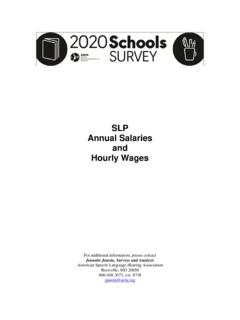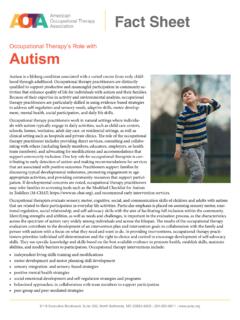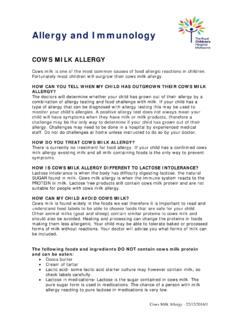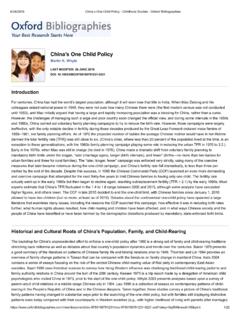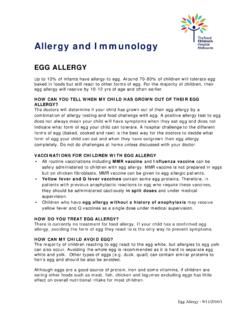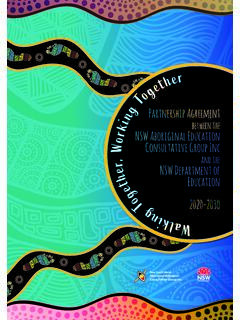Transcription of Effect of Child Centred Methods on Teaching and Learning ...
1 Journal of Education and Practice ISSN 2222-1735 (Paper) ISSN 2222-288X (Online) , , 2016 1 Effect of Child Centred Methods on Teaching and Learning of Science Activities in Pre-Schools in Kenya Nelly C. Andiema school of Education, University of Eldoret, Kenya Box 1625-30100 Eldoret, Kenya The research was funded by the author herself Abstract Despite many research studies showing the effectiveness of teacher application of Child -centered Learning in different educational settings, few studies have focused on Teaching and Learning activities in Pre-Schools. This research investigates the Effect of Child centered Methods on Teaching and Learning of science activities in pre-schools in West Pokot County, Kenya. The study was descriptive in nature as it sought pre- school teachers and head teachers views. The instruments used for this study were; questionnaires, interview guide and observation checklist by the researcher.
2 A total of 168 teachers and 35 head teachers responded to the research questionnaires. The research results showed that there existed significant relationship (p< ) between four Child centered approaches and pupils Teaching and Learning of science in public early childhood education centres. For instance, use of Child discovery (r= and p= ) and activity based approaches (r= and p= ) had higher correlations compared to Child interest (r= and p= ) and Child needs approaches (r= and p= ). The study concluded that teachers use of Child - Centred approaches affected pupils acquisition of science skills in schools. The study recommends that teachers should change their classroom Learning to allow learners regular interaction with the outside the classroom (active Learning ). Keywords: interest, discovery, need, science, activities 1 Introduction Child -centered Teaching is placing the pupil at the centre of the Learning process in classroom (Gravoso, Pasa, Labra & Mori, 2008).
3 The teacher provides pupils with opportunities to learn independently and from one another and coaches them in the skills they need to do so effectively (Collins & O'Brien, 2003). The original education schedule considered to be teacher-centered placed all the emphasis on the teacher and not the student, still dominates the education scene. In the traditional epoch, many Teaching practitioners widely applied teacher-centered Methods to impart knowledge to learners comparative to student-centered Methods (Munyaradzi, 2013). With the advent of the concept of discovery Learning approach, scholars widely adopt more supple Child -centered Methods to enhance active Learning in classrooms. According to Hesson and Shad (2007) observed that most teachers today apply the Child centered Teaching approaches to promote interest, analytical research, critical thinking and enjoyment among pupils in schools. The Teaching method that a teacher uses is regarded more effective since it does not centralize the flow of knowledge from the teacher to the learner.
4 Questions about the effectiveness of Child -centered Teaching Methods on pupils Learning have consistently raised considerable interest in the thematic field of educational research. In addition, it is not clear whether teachers in early Child hood development education (ECDE) schools utilise Child -centered approaches in instruction in Kenya, a focus of this paper. Early Childhood Care and Education (ECCE) supports children s survival, growth, development and Learning including health, nutrition and hygiene, verbal and cognitive, social, physical, esthetic and emotional development from birth to primary school in formal, informal and non-formal settings. Education systems in the majority of developed countries have been recently paying more attention to the early childhood education. The importance of consistent education of children, starting from the earliest age (of several months) to 7 or 9 years (usually this is the age when children go to school ) is substantiated by numerous studies and practice in many countries.
5 For the purpose of Teaching at any level of education is to bring a fundamental change in the learner (Tebabal & Kahssay, 2011). To facilitate the process of knowledge transmission, teachers should apply appropriate Teaching Methods that best suit specific objectives and level exit outcomes. This paper analyses the relationship between pre- school teachers application of Child -centered approaches and science activities Teaching . This is because one of the purposes of science Teaching in ECDE is to enhance pupils understanding of scientific concepts. Another aim is to develop children s capacity to understand scientific procedures and to investigate scientifically (Ediger, 2013). Susanne and Shu-Nu (2014) said that pupils need to know, understand and be able to be scientifically literate at different levels of education and connect scientific literacy with learners everyday experiences, curiosity in the hope that pupils become able to describe, explain and predict, read about science in popular press, discuss and evaluate information with science content.
6 According to Ng asike (2012), in Kenya, science is a key subject that children study at all institutions of Learning from early childhood to university. Science is critical in providing pupils with essential skills needed Journal of Education and Practice ISSN 2222-1735 (Paper) ISSN 2222-288X (Online) , , 2016 2 for accelerating economic growth through industrialisation and advancement in technology (MoES&T, 2005). The primary school curriculum in Kenya has embedded the perspectives of science education, in which pupils skills in making socio-scientific decisions has been stressed. Ediger (2013) found out that Teaching science is not an easy task especially in pre- school implying that teachers have to put more extra effort to ensure the goals of science education are realised. Science Teaching Methods need to incorporate how scientists work in the field.
7 Problem solving and critical and creative thinking are necessary ingredients in ongoing science units of study. Individual differences need to be considered when implementing holistic Teaching and Learning (Ediger, 2013). Textbooks and reading materials should be available for pupils to use in ongoing lessons (Ediger & Rao, 2009). Additional factors in instruction which must be tended to include the following: observing natural phenomenon carefully and accurately, developing reading skills which encourage quality comprehension, synthesis of gathered information, and development of accurate conclusions, writing which reflects thoroughness, standard English usage respective of background and ability level, appropriate sequence and syntax, and clarity in semantics, speaking in a meaningful, coherent manner respective of background and dialects and listening for a variety of purposes including answering questions and categorizing vital ideas in science as facts, concepts, and generalizations.
8 Pupils should participate in small groups where the circulation and acceptance of others ideas is valued in an atmosphere of respect (Ediger, 2013). When these Methods are applied, pupils will aqquire necessary scientific skills to increase their skills. Ng asike (2012) analysed teacher training in science education in early childhood development and primary grades in Kenya. The author found out that training of science teachers in early childhood and primary colleges nationally triggers a lot of quality questions. This was despite government emphasising science as critical for the achievement of vision 2030. This shows that training of preschool teachers at early childhood levels continues to face challenges in Kenya. The Kenya education policy describes the curriculum of ECD as anchored in experimental Learning Methods . However, the policy also acknowledges that there is pressure in ECD for teachers to ensure preschool children are provided an academic head start in preparation for primary school entry.
9 Scientific knowledge is important in our daily lives. The ECDE curriculum is designed to ensure that learners are grounded with scientific knowledge by the time they are finishing nursery school . When learners develop interest in science activities while they are still in nursery schools, the country is sure of getting future doctors, engineers, physicians, environmentalist, and botanists among others. Therefore, the use of Child - Centred approaches is supposed to increase learners intrinsic motivation to learn scientific ideas while still young. This study sought to determine the degree to which Child - Centred approaches were being used by ECDE teachers in the Teaching and Learning of Science activities in public ECDE centres in West Pokot County. Problem Statement The purpose of conducting this study was to determine the reason for pre- school pupils low level of scientific skills when joining standard one in public primary schools in West Pokot County.
10 Approaches have been made by government of Kenya to improve science Teaching in schools but pre- school teachers have been overlooked despite the existence of science curriculum at this level, which covers the ages 3 6 years (MoE, 2004). Therefore, it is not known whether pre- school teachers are utilising Child -centered approaches in Teaching and Learning of science activities in West Pokot County, a focus of this paper. Purpose of the Research The main purpose of this research is to investigate the degree to which pre- school teacher are utilising Child -centered approaches in their classrooms. Moreover, the study seeks to determine how the approaches affected pre- school learners acquisition of science skills. 2. Literature Review Science is a body of knowledge that includes observation, measurements and calculations in an attempt to understand the natural world and solve puzzling questions and problems in the society (KIE, 2008; Buyuktaskapu, 2011).










